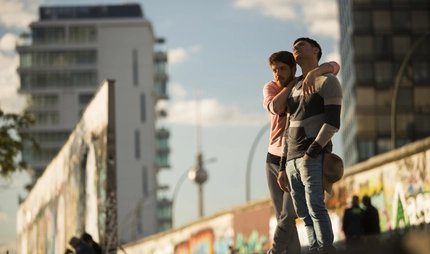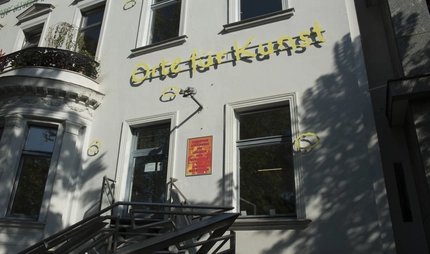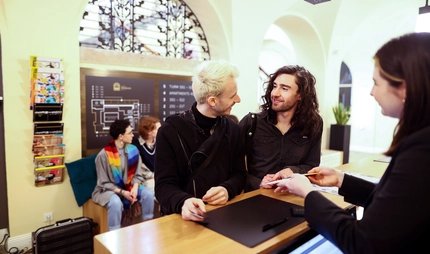
Schwules Museum (Gay Museum)
Promoting tolerance and diversity
In Berlin's Gay Museum you will always gain new insights into the world of the gay, lesbian and transgender scene. Changing exhibitions provide authentic insight into queer lifeworlds and identities.
The Schwules Museum is a jewel among Berlin’s museums with its exhibitions, library and archives. It’s one of the world’s biggest institutions for researching, preserving and communicating the history and culture of queer communities.
Curated art and temporary exhibitions
Founded in 1985, the Gay Museum has been showing curated art as well as has displayed treasures from its own collection in temporary special exhibitions ever since. When it moved to Schöneberg’s rainbow neighbourhood, the gay museum expanded its repertoire. Today it not only presents gay, but also lesbian, trans, bisexual and queer life stories. It’s a unique place that reflects the diverse art, culture and history of the LGBTIQ+ communities and, with its location in Schöneberg's Regenbogenkiez, is the ideal starting point to explore the LGBTIQ+ scene in Berlin.
Visiting the Schwules Museum takes you on a walk through the history of Berlin's LGBT community. Find out about the life of Charlotte von Mahlsdorf, gay icon and transvestite in former East Germany. In the main exhibition space, you can see photos, videos, postcards, letters and items of clothing. There is also a library and archive where you can browse through university publications or lifestyle magazines from the 1990s. Stay later and catch an evening lecture on topics as diverse as experiences of coming out, celebrity culture or sad testimonies about persecution and intolerance.

Take a break in the café on the ground floor of the Gay Museum. Run by the many volunteers who also help at the ticket office and partly also with the design of the museum, you are welcome to ask for tips for your exploration tour here. In the foyer you will find flyers on current events of Berlin's queer scene and also a small selection of books.
The four exhibition rooms of the museum are also located here on the ground floor. After registering, you can read, research and browse on the upper floor: the presence library now has over 16,000 volumes, with the oldest surviving book on the subject dating back to the 16th century. You will also find numerous current periodicals. Browse through magazine collections or take advantage of the opportunity to watch VHS tapes and films on request.

On the history of the Gay Museum
Berlin needs a museum for gay history! In the 1980s, students Andreas Sternweiler, Wolfgang Theis and Manfred Baumgardt make that possible. In 1984, the first exhibition opens, entitled "Eldorado - Homosexual Women and Men in Berlin 1850-1950" within the exhibition space of the Berlin Museum. The project that is frowned upon by some, but the students continue with the aim of increasing acceptance and tolerance.
The following year, the "Association of Friends of a Gay Museum in Berlin" is formed with a change of venue: a museum with a library and archive is installed in a building belonging to AHA, a gay rights working group. The first exhibition takes place on the 750th anniversary of Berlin's founding and is a huge public success. As the library and the archive grows, the museum changes location twice more.
Research archive
Today, researchers visiting the Lützowstraße building have access to a huge collection of material from the gay scene. In the basement archive, more than 50,000 objects on various topics are now neatly archived. In the library, you can browse through lifestyle magazines of the 90s or university theses. The spectrum ranges from coming out to star cult to sad chapters of persecution and intolerance. On request, you can look at and listen to many things - from old postcards and recorded lectures to records and VHS tapes.
Thematic highlights include the collection on Magnus Hirschfeld's Institute for Sexual Sciences, materials on the women's and lesbian movement or the work of Jürgen Baldiga, who in 1984 became infected with HIV, which was new at the time, and documented his AIDS illness with photos, Super 8 films and diary-like notes. You can visit Baldiga's grave at the Old St. Matthew's Churchyard in Berlin-Schöneberg.
5 Key Points of the Schwules Museum

- "Gay, lesbian, Jewish" travelling exhibition.
- Large collection of around 1,500 Japanese comics.
- Sponsorship opportunities.
- Relics from Rudolf Klimmer and Charlotte von Mahlsdorf.
- 600 Super 8 films from the '70s
Welcome to Schöneberg's Rainbow District

From the Gay Museum you walk a little more than ten minutes to the Nollendorfkiez. Motzstraße, which branches off from Nollendorfplatz, is where the Lesbian-Gay City Festival is celebrated every year. Stroll along Kleiststraße and take a detour to Eisenacher Straße and Fuggerstraße. Throughout the neighbourhood you will also find many queer bars, pubs, shops and other offers for the LGBTIQ+ community.
Nearby attractions
Lützowstraße is at the heart of a cultural and artistic area. 5 minutes' walk from the Schwules Museum* brings you to the Haus am Lützowplatz, a gallery of contemporary art and design. The theme of the Gedenkstätte Deutscher Widerstand memorial is resistance to the Nazi regime, and you can learn about leading figures such as Stauffenberg and the Scholl siblings.
See more about cinema and television in the Museum für Film und Fernsehen at Potsdamer Platz, home to a large collection of props from German film history, including memorabilia connected to Marlene Dietrich, who also features in the Schwules Museum. Take a stroll along Potsdamer Straße, and you'll find some innovative galleries and studios. This is also a perfect place to stop for lunch as there are plenty of restaurants to choose from.
Practical tips from visitBerlin
- The Schwules Museum* is in Lützowstraße in the Tiergarten area of Berlin. Take the U1 subway line to Kurfürstenstraße station and walk 800 m to the entrance of the Schwules Museum*. Alternatively, take the M29 bus route which leaves from Kurfürstendamm. By car, park at Potsdamer Platz and then travel the rest of the way by bus.
Discounts with the Berlin WelcomeCard
- The archive and library can be visited for research purposes without appointment. If you wish to see the library's film collections, these can be viewed in the media workspace if you have booked beforehand.
- Groups of five people or more should also book in advance.
- The museum offers free guided tours in either German or English. Currently public tours of the exhibitions take place every Thursday at 6pm and Saturday at 4pm. Registration is not necessary.
Please refer to the website for opening hours.



